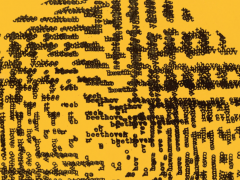ATypI 2010 Dublin: Dr. Dan Reynolds on Victor Hammer
Austrian-born American painter, sculptor, printer, and typographer Victor Hammer, most well-known among type designers and typographers for his uncial typefaces was true to one thing. To service the language.
Victor Karl Hammer (September 9, 1882 – October 7, 1967), was an Austrian-born American painter, sculptor, printer, and typographer. He was born in Vienna, Austria to Karl and Maria (Fuhrmann) Hammer.
Hammer produced his first type design, Hammer Uncial, in 1921. In 1922, he moved to Florence, Italy, where he set up a printing press and seven years later he moved his printing operation into the Villa Santuccio in Florence naming it the Stamperia del Santuccio.
The first book that was printed in this operation was Milton’s Samson Agonistes (1931), using what would be known as his Samson Uncial type. Punches for the type were cut by Paul Koch, son of Rudolf Koch. Hammer moved to Kolbsheim in Alsace in 1934, where he designed and built a chapel on an estate for a friend.
From 1936 to 1939, Hammer lived in Vienna, where he served as a professor at the Akademie der Bildenden Künste. In 1939, he fled the Nazis and immigrated with his first wife to the United States, leaving behind all his cutting and casting tools and most of his fonts. He taught at Wells College in Aurora, New York until 1948. There, he created American Uncial – the best-known of his five typefaces.
Hammer built his wooden press in 1927 with the help of local Florentine craftsmen based on a press in the Laurentian Library; in 1960, the Laurentian’s press was discovered to be a copy constructed in 1818. It was first used to print Samson Agonistes. When he closed his studio in 1933, the press was stored. In 1954, it was moved to the University of Kentucky where it has been in use by the King Library Press since 1959.
Following is an excerpt of type designer and educator Dr. Dan Reynolds’ presentation on Hammer, an “original craftsman” at the 2010 conference of the Association Typographique Internationale in Dublin.
“Like Edward Johnston, who would have also described himself in such terms, he was inspired by early Medieval manuscript hands, though in Hammer’s case, they were probably more Irish than English examples. Hammer’s printing is historicist in the same sense as William Morris’s books. Rudolf Koch is reported to have once said the following to Hammer:
‘You are fortunate, Victor, that you are an outsider and not a professional. I cannot do what you do. I must meet the demands of our customers and sometimes those of the market. We, professionals, have to stick to one line and can only ill afford to look right or left [Middeldorf 1952: 168].’
In 1946, Hammer wrote that ‘it is not the reader and his demands that I wish to satisfy […] it is my conviction that the type designer should do his work in the service of language’ [Hammer 1946].
When he did consider Insular letterforms, Hammer examined their forms and saw the languages they were used for. He wanted to bring something of this beauty that they had in the Latin language to contemporary typefaces that would compose modern languages. When an Irish designer expressed interest in using the Hammerschrift, he went along with it. Nevertheless, I do not see any strong connections between his ideas and ‘Irish’ design. That association comes from the way his typefaces are used today, and perhaps also from the way that type-makers have marketed them.
Victor Hammer’s association with Gebr. Klingspor lasted for more than three decades and was not entirely broken by geographic distance, the Nazi takeover of Germany and Austria’s political and social systems, or the destruction of Europe during the Second World War. Some of Hammer’s fidelity to Gebr. Klingspor must be traceable to his strong friendship with the Koch family, even after Rudolf Koch died in 1934 and Paul Koch in 1945.
Although Hammer was never a member of Koch’s Offenbacher Werkstatt, he inspired its practice, and – more importantly – several of its members collaborated with him. His relationship with Fritz Kredel even continued in the United States. Rudolf Koch’s friend Siegfried Guggenheim was probably Werkstatt’s most significant patron, but Hammer may have been the external artist most closely related to it and the most significant custodian of its memory in the United States.
When Hammer’s uncials were described – at least until the photo and digital type age – the adjective used most often about them was ‘medieval,’ and not ‘Irish,’ as would certainly be the case in time. While I suspect that this is also how Hammer would have viewed his uncials, I nevertheless suspect that he must have agreed with the following statement from Ó Lochlainn:
‘Here come the Irish in the twentieth century, as often in former ages, with a gift to Europe. To a Europe which has rung the changes in Gothic, Roman, and Italic types, until it would seem that nothing more can be evolved except atrocities, Ireland offers a fresh and unspoiled, an old yet modern, an ancient but still living script, full of charm, full of suggestion for designer and type cutter.’
I think that I can agree with Ó Lochlainn, too.”
Read Dr. Dan Reynold’s extensive and insightful post on Hammer here.
Established by a group of “friends dedicated to the promotion, study and appreciation of the legacy of artist Victor Karl Hammer” The Victor Hammer Society aims to be a place of discovery for those who are not yet familiar with the work of a man known mostly to his patrons, their heirs, and his students.
Tags/ typeface, type design, atypi, type designer, dan reynolds, victor hammer, unicial






.jpg)





.jpg)




.jpeg)


